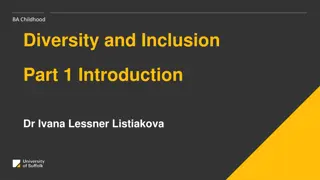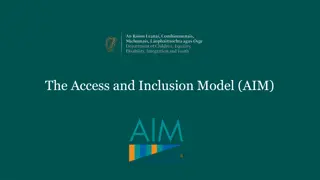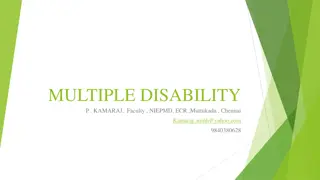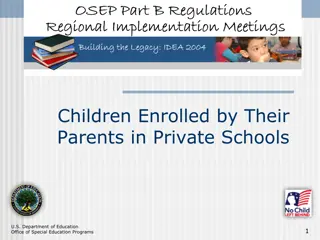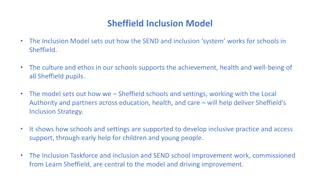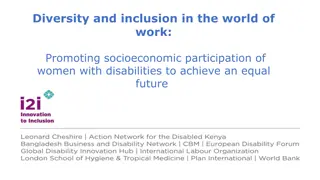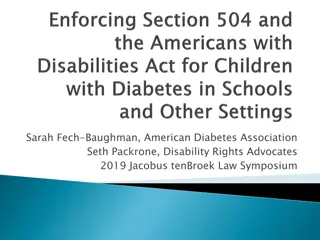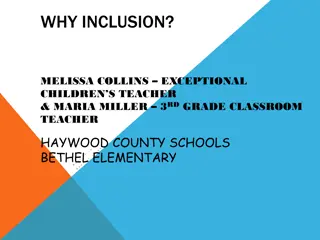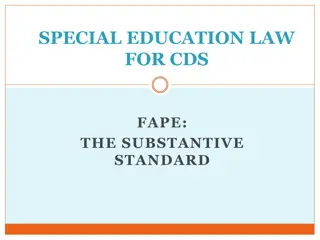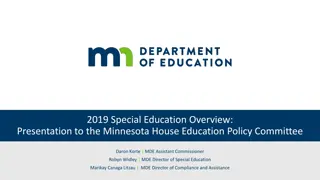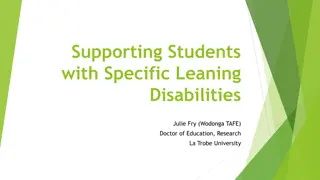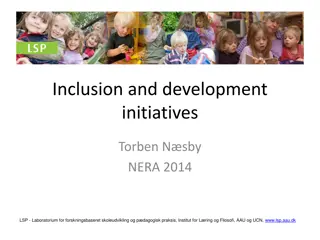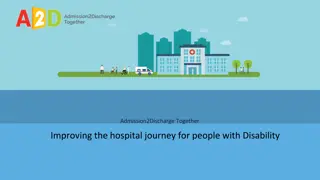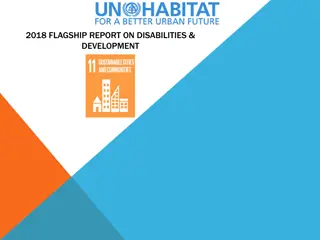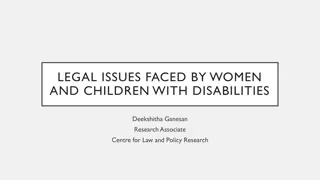Education and Inclusion of Children with Disabilities in the United States
The history and evolution of educating and caring for children with disabilities in the United States, from community responsibility to the Disability Rights Movement. Legislation such as the Individuals with Disabilities Education Act of 1997 has aimed to ensure inclusion, as seen in requirements for the Least Restrictive Environment (LRE). Recent amendments address concerns about over-identification and restrictive placements, emphasizing the need for challenging academic standards for all students. The National Council on Disabilities continues to focus on the segregation of students with disabilities, advocating for inclusive education practices.
Download Presentation

Please find below an Image/Link to download the presentation.
The content on the website is provided AS IS for your information and personal use only. It may not be sold, licensed, or shared on other websites without obtaining consent from the author.If you encounter any issues during the download, it is possible that the publisher has removed the file from their server.
You are allowed to download the files provided on this website for personal or commercial use, subject to the condition that they are used lawfully. All files are the property of their respective owners.
The content on the website is provided AS IS for your information and personal use only. It may not be sold, licensed, or shared on other websites without obtaining consent from the author.
E N D
Presentation Transcript
All I want for Christmas is my two front teeth LRE All I want for Christmas is My LRE My LRE My LRE Gee, if I could only have my LRE Then I would have a Merry Christmas"
34 C.F.R. 300.114 LRE Requirements (2)Each public agency mustensurethat - (i) To the maximum extent appropriate, children with disabilities, including children in institutions or other care facilities, are educated with children who arenondisabled; and (ii) Special classes, separate removal of children with disabilities from the regular educational environment occurs only if the nature or severity of the disability is such that education in regularclasses withtheuseof supplementaryaids services cannot be achieved satisfactorily. public or private schooling, or other and
Attitudes and Beliefs Towards Children with Disabilities
History In the United States 1700 to early-1800: Educating and caring for children with disabilities was the family and community's responsibility. Late-1800: Dawn of asylums for care and training of children with disabilities. Late 1900: Disability rights movement focusing on the individual s needs. Education for All Handicapped Children s Act of 1975 ( EAHCA ) Individuals with Disabilities Education Act of 1997 ; Amended 2004
January 2017: IDEA Amendments at 34 C.F.R. 300.646 - 300.647 These final regulations also address the well-documented and detrimental over-identification of certain students for special education services, with particular concern that over-identification results in children being placed in more restrictive environments and not taught to challenging academic standards. (emphasis added) Office of Special Education and Rehabilitative Services, Department of Education (December 19, 2016)
National Council on Disabilities The Segregation of Students with Disabilities (February 7, 2018) nationally, students with disabilities, in particular students of color and students in urban settings, as well as students with specific disability labels (such as autism or intellectual disability), continue to be removed from general education, instructional, and social opportunities and to be segregated disproportionately when compared to White students who live in suburban and rural areas and those who have less intensive academic support needs.
2015-2016 Texas LRE Statistics Inside General Ed Class 80% or More of the Day Inside General Ed Class 40% through 79% of the Day 15.88 Inside General Ed Class Less than 40% of the Day Separate School or Residential Treatment Center 0.62 68.13 14.60
What weve got here is a failure to communicate. Growth = Lack of Communication Different departments Different roles Different job responsibilities There are not enough hours in the day to train everyone on everything
Attitude and Beliefs Towards Students with Disabilities State Governor and Legislature State Commissioner and Department of Education Local Superintendent of Schools and School Boards Special Education and Section 504 Directors and Administrators Teachers Parents & Guardians Advocacy Groups (Specific disabilities, teachers, school nurses, etc.)
2019 Special Education Hearing Decisions Student v. Highland Park Independent School District; TEA Docket No. 222-SE-0319 (June 28, 2019) Hearing Officer David Berger Parent wanted a more restrictive placement of homebound.
2019 Special Education Hearing Decisions Student v. Round Rock Independent School District; TEA Docket No. 307-SE-0519 (September 5, 2019) Hearing Officer David Berger Parent wanted a less restrictive placement of general education only.
2019 Special Education Hearing Decisions Student v. Hallsville Independent School District; TEA Docket No. 316-SE-0519 (September 25, 2019) Hearing Officer Deborah Heaton McElvaney Parent wanted a more restrictive placement in a residential treatment center ( RTC ).
2019 Special Education Hearing Decisions Student v. Frisco Independent School District; TEA Docket No. 270- SE-0419 (August 29, 2019) Hearing Officer Kasey M. White Parent wanted a less restrictive placement of general education and inclusion in all core classes.
2019 Special Education Hearing Decisions Student v. Sweetwater Independent School District; TEA Docket No. 056-SE-1018 (April 1, 2019) Hearing Officer Kathryn Lewis Parent wanted a more restrictive placement in a self-contained special education classroom.
They already know the law Now What? 1. Attitudes and district/campus traditions 2. Can and Should are two different matters 3. Support from the school board and administrator 4. There is no I in TEAM 5. Culturally responsive teaching 6. Address behaviors in the general education setting 7. Empowerment training 8. Take time to listen and explain (parents and advocacy groups) 9. Vote
Geneva L. Taylor, Partner Powell, Youngblood, & Taylor LLP Arena Tower One 7322 Southwest Freeway, Suite 1900 Houston, TX 77074 gtaylor@pyt-law.com (713) 779-7500


